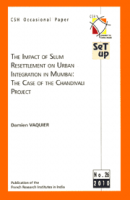Aligning Development, Air Quality and Climate Policies for Multiple Dividends

Abstract
This paper proposes that environment protection should be made complementary to the development process, by aligning different policies that avoid trade-offs and generate multiple dividends during policy implementation. This is especially true for developing countries where crucial development policies with long-term implications are being formulated. There is a good opportunity to align development, local air quality management and climate change policies that both reduces costs and achieves multiple dividends. Empirical evidence, including the Environmental Kuznets’ Curve, shows that, as a country progresses economically, concern develops for the environment due to availability of resources and public pressure. This is found more for local pollutants, while preventing greenhouse gas emissions need conscious policymaking. This approach is reflected in developing countries, where air quality problems are being addressed individually. A more pro-active approach would generate no-regrets options, moving a country on a pathway that prevents local air quality deterioration and is also less carbon-intensive. Since developing countries fear that climate change negotiations can impede development, developed countries should support their move to align policies by directing climate-related as well as public/private flows towards a development-oriented pathway. This would create leverage effects on implementation of domestic policies and help overcome transaction costs. A win-win situation can thus emerge, which addresses the developing countries’ concerns of development and local air quality management along with the global concern for climate change.
Taking India’s case, this paper looks at policies in the planning process incorporating the environmental agenda. The focus is on preventing local air quality deterioration. But, since benefits related to preventing greenhouse gas emissions often lie at the margin, conjoint benefits can be obtained at optimal costs. This paper looks at measures like use of CNG in public transport and development of mass rapid transit systems. Systems like the Metro Rail address congestion problems besides providing suitable means of public transport. Similarly, promoting CNG on environmental grounds would enhance CNG availability for power generation. Research shows opportunities for conjoint mitigation of CO2 and SO2 emissions from the power sector. Adoption of these measures requires conscious attempts by national policymakers, with support in the form of technological and investment flows from developed countries.
Table of Contents
Introduction
1. Inter-linkages between development, climate change and air quality
2. Development and energy use
3. Existing policy approaches of developed and developing countries
4. Case for aligning policies in developing countries
5. Paper structure
I. Economics of Alignment
1. Environmental Kuznets’ Curve
2. No-regrets options
3. Leverage effects of alignment
II. Multiple Dividends from Alignment: Indian Experience
1. Energy and environment profile
2. Existing policies linking development and environment
3. Alternate policies and measures
III. Developing an Architecture for Alignment
1. Policy approaches
2. Shifting towards an environment-friendly pathway
3. Global mechanisms to facilitate alignment, with emphasis on climate change negotiations
4. Some specific policy options
IV. Conclusion
Bibliography
Appendix I: AIM/Local Model
- In :CSH Occasional Paper N°21
- Year :2007
- Pages :95
- ISSN :0972-3579







